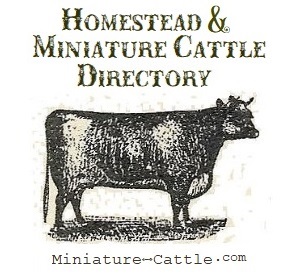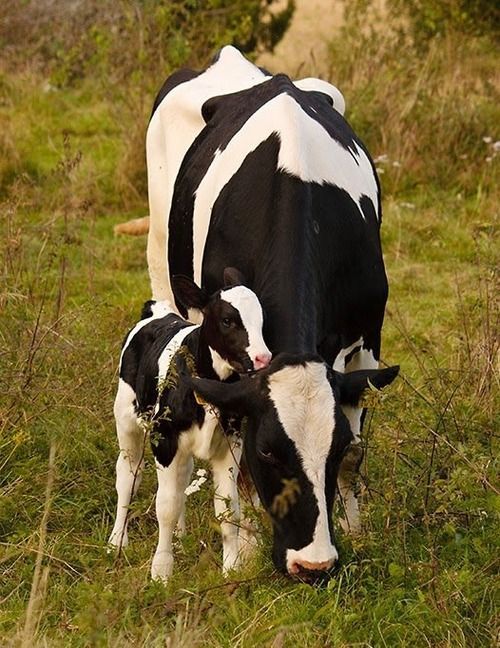
Calf Rearing: an Advanced Course
The Best Age to Wean • When to Raise a Calf on a Bottle
required reading for homesteads that want to raise healthier, happier herds AND make more money
this is the Cliff Notes version ~ read the full unabridged Cornell University report here
"We raise our calves on mother cows, despite a steady flow of negative feedback about doing so."
Net profits and herd health benefits prove: "Each of our cows raise her own calf, and only her own calf, for a full ten months... the health and nutrition our cows get in the first ten months set the stage for a lifetime of the same."
"... We tried many methods of calf rearing: bottle feeding, bucket feeding, grain, buckets with nipples, and nurse cows... We never lost a calf, and by general standards our calves always grew extremely well and looked extremely healthy. Having raised calves on cows in earlier years, however, we always knew there was something better."

"When we began [small farm grassfed] commercial dairying, we knew that we would not make any real progress (and therefore money) until we raised our replacements on their mothers. Since we have been doing this, the benefits have reached all aspects of our operation. Raising our replacements on their mothers is by far our best investment with the biggest payback. Even as the profitability of our cows increases—as it does each year, especially as we add our more efficient, lower maintenance cows raised on their mothers, and we reach [higher net profits]... [the heifer is raised for a fraction of the cost on its mother, which results in] an excellent price for that heifer. Factoring in that we never lose or have to treat a calf for illness and will have years of health benefits, the system is a bargain.
"The health & growth that our replacements obtain in their mothers’ care has astounded us. High-butterfat cows produce the fastest growing, healthiest calves. We have had people tell us that it must be a “breed thing,” because they have seen relatively small and malnourished calves that are of comparable age to ours, and ours truly do almost look like a different animal. It is not a “breed thing”; the breeds we have raised are typical dairy breeds and crosses (Holstein, Fresian/Holstein, Jersey, Ayshire, along with Dutch Belt, Milk Devon, Lineback, and others). Most breeds will reach 600 pounds before weaning age in their mother’s care. The results are not the same with nurse cows, not even with a one-to-one cow-calf ratio. The special relationship between the mother and her calf does not translate to even the most enthusiastic nurse cow. A calf will be healthiest on her own mother’s milk. The milk from a cow matches specifically to her own calf, changing as the calf matures. There is no danger of losing calves to illness; scours and respiratory infection (colds or runny noses) resolve without incident or the need for any intervention.
"Heifers raised on their mothers will get nice fat maiden udders, and we believe that this fat contributes to healthy mammary gland function, which supports milk production, resists mastitis, and very likely improves the quality and nutrition of the milk once she begins producing. As for rumen development, mothers’ milk will provide for full and proper development, including vascularization and capacity. Our calves are super-capacious even at six months old. In addition, the perfect fat in mother’s milk plays an essential role in not only bone development, but also is most important in the developing endocrine system.
"Perfect endocrine system development should be the centerpiece of discussions of calf rearing. Generally, debate revolves around rumen and bone development. We focus on the endocrine system development, however, because it governs glandular function and hormone production. These in turn translate into the most important issues for our cows’ production years: lactation and gestation. Let’s face it, we lose money when we feed a cow that is not producing calves and milk; nothing costs a dairyman more than an open cow. Growth, breeding cycles, healthy gestation, and strong lactations are all functions of the endocrine system. And it takes ten months on mother’s milk for the endocrine system to fully develop.
"It should be noted that use of the term “replacements” includes bull calves as well. We raise our bull calves in the same manner so that they will obtain early sexual maturity, strength, stamina, and the very important high sperm count with excellent motility, along with full genetic expression.
Full genetic expression of traits is a very valuable element gained by raising calves this way. As breeders, we strive to improve our herd, a job that cannot be accomplished effectively unless we can see our cows as an expression of their full genetic potential. One cannot properly select the best cows and bulls for improving the herd if one cannot see the full genetic expression of their traits. We believe only cows and bulls raised 10 months by their mothers reach full genetic expression.
"The most difficult aspect of raising replacements on their mothers is finding the courage to try it. It is not a process without kinks. But if you get started and are determined to make it work, you will never go back to any other method."
Paul & Phyllis Van Amburgh and family operate Dharma Lea Farm in Sharon Springs, New York where they produce 100% grass fed milk and beef on their 90-cow certified organic dairy and their 20-cow Heritage Devon beef herd. The Van Amburghs can be reached at dharmalea@gmail.com. You can also find the Dharma Lea Farm in the Homestead & Miniature Cattle Breeders Directory.
Sources & Resources

Read the unabridged article and learn about raising calves on their mothers in a milking dairy: Calf Rearing: An Advanced Course, Cornell University Small Farms Program, 2011.
Dairy Farm Pushes the Limits: Grass and Genetics, Dharma lea farm; Cornell University Small Farm Program, 2010
Holistic Management Realized at Dharma Lea Savory Hub, Savory Holistic Management Institute, 2016
Calving Basics: The Newborn Calf's First 15 Minutes. Required Reading for homestead herd health: What you do—or don’t do—in the first few minutes after a new calf is born, can impact her health & performance for the rest of her life. Includes a sharable infographic listing 5 facts about Colostrum.
“Early separation of cow and calf has long-term effects on social behavior.” ScienceDaily. University of Veterinary Medicine, Vienna.
Late Weaning Option - Angus Beef Bulletin, 2014.
Calves learn a lot from their mothers regarding eating habits, etc. The longer you can keep them with their mothers, the better the calves will do. The biggest thing about later weaning is how much easier it is, with fewer problems and less sickness.
Normal VS Early and Late Weaning (pdf) - University of Florida Animal Science, IFAS, Agricultural Research and Education Center, Ona, and Food and Resource Economics Department, Gainesville, by Findlay Pate and Tom Spreen. Better timing of marketing, fatter, healthier calves, and no negative affect to momma cows that produce just as many calves over their lifetime.
Late Weaning. The Canadian Cattleman Beef Magazine, by Heather Smith Thomas. “One of the highest input costs when raising cattle is winter feeding. Some ranchers are shaving winter feed costs and labour by wintering their summer-born calves with the cows and not weaning the calves until spring. Leaving calves with cows through northern winters works best with moderate-milking cows, and not so well with heavy-milking cows that take more nutrition for lactation. “It is easier to supplement calves through winter using their mother’s milk, than to supplement them with grain. As the calf ages, it becomes more adapted to consuming grass. The natural lactation curve matches the needs of the growing calf; the closer the calf gets to adulthood (and the closer the cow gets to the next calf being born) the less milk is produced... Some producers think they have to wean their calves before winter or udders will freeze and be damaged, but there are plenty of fall-calving herds to disprove that idea.”
Bull or Heifer Calf? How to influence calf gender the old fashioned way; a bit of passed down “grandfather homestead wisdom”
Weaning by the sign: “Another option available that many people use is weaning based on the Moon phases / signs. One “rule” for weaning is to do it when the Moon is the signs of Sagittarius, Capricorn, Aquarius and Pisces. These signs rule the thighs, knees, ankles, and feet, and the dates listed in the Farmers’ Almanac are based on this rule.”
photo credit: Holstein cow & calf; source unknown; found on Pinterest.

Homestead & Miniature Cattle Directory

Homestead Cattle Association

Homestead & Miniature Cattle Registry
Heritage Cattle Registry

©published online 2020

